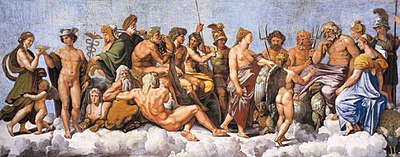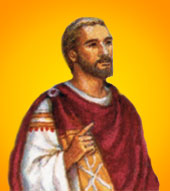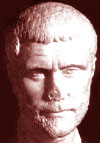Confucius (Kong Fu Zi)
Confucius
Confucius (Chinese: 孔子; pinyin: Kǒng Zǐ; Wade-Giles:
K'ung-tzu, or Chinese: 孔夫子;
pinyin:Kǒng
Fūzǐ;
Wade-Giles: K'ung-fu-tzu), literally "Master Kong", (traditionally 28 September 551 BC -
479 BC) was a Chinese thinker and social
philosopher of the Spring and Autumn Period.
His Philosophy
The philosophy of Confucius emphasized personal
and governmental morality, correctness of social relationships, justice and
sincerity. These values gained prominence in China over other doctrines, such
as Legalism (法家) or Taoism (道家) during the Han Dynasty (206 BC - AD 220). Confucius'
thoughts have been developed into a system of philosophy known asConfucianism (儒家).
Because no texts survive that are demonstrably
authored by Confucius, and the ideas most closely associated with him were
elaborated in writings that accumulated over the period between his death and
the foundation of the first Chinese empire in 221 BC, many scholars are very
cautious about attributing specific assertions to Confucius himself. His
teachings may be found in the Analects of Confucius (論語), a collection of aphorisms, which was compiled many years
after his death. For nearly 2,000 years he was thought to be the editor or
author of all the Five Classics (五經) such as the Classic of Rites (禮記) (editor), and the Spring and Autumn Annals (春秋) (author).
Confuciu's Principles
Confucius' principles had a basis in common
Chinese tradition and belief. He championed strong familial loyalty, ancestor
worship, respect of elders by their children (and, according to later
interpreters, of husbands by their wives), and the family as a basis for an
ideal government. He expressed the well-known principle, "Do not do to others what you do
not want done to yourself", one of the earlier versions of the Golden
Rule.
Confucius was a Chinese philosopher who
was born in 551 BCE. Confucius is a corruption of the name K'ung Fu-tzu. Although
K'ung Fu-tzu was the philosopher's correct name, he has historically been
referred to as Confucius in Western countries.
The Religion
The religion of Confucianism derives
its name from Confucius, and is based on his writings. These writings were
intended to be advice for the rulers of China in the sixth century BCE, and
were later studied by the followers of Confucius. In addition, his followers
brought in ideas originating in Buddhism and
Taoism, as Confucianism spread from China to other Asian countries, including
Korea, Japan, and Vietnam.
One idea emphasized by Confucius was "beautiful
conduct." He thought that if everyone in a society could achieve
"beautiful conduct," or what he considered correct behavior, society
could become perfect. This involved avoiding all extreme actions and emotions,
being considerate to others, respecting family, and worshiping ancestors.
Confucius may not have considered himself to have founded a
religion. He was a philosopher, not a prophet, and did not emphasize
spirituality, but instead certain behaviors and being a good citizen. He
believed that five relationships formed the basis of a stable, happy society.
These five relationships include those between ruler and subject, older brother
and younger brother, father and son, husband and wife, and the relationship
between two friends.
Confucius Describes As...
Confucius (Kong Fu Zi), a humble man from poor beginnings, became so influential that his teachings inspired a philosophy, a religion, and a way of life that has lasted until today.
From his basic "sayings" in The Analects, or discussions, there developed a philosophy, a social system and a political system which was based on harmony, tolerance, and merit.
Confucius was born in answer to his parents' prayers at a sacred hill called Ni. Confucius' surname Kong means literally an utterance of thankfulness when prayers have been answered.
At the age of fifty, when Duke Ding of Lu was on the throne of Lu, Confucius' talents were recognized and he was appointed Minister of Public Works and then Minister of Crime. It seemed that Confucius’ dream of a position of influence in government had come true. But Confucius apparently offended members of the Lu nobility and he was forced to leave office and go into exile. He returned to Lu in 484 BCE and spent the remainder of his life teaching, putting in order the Book of Songs, the Book of Documents, and other ancient classics.
He gathered students around him and taught the basics of what is today called Confucianism. He taught decorous, courtly behavior, duty to rulers, parents, and older brothers. He taught that you should not do to others, what you would not want done to yourself.
Confucian Philosophy
Confucian philosophy seeks a harmonious society, not dependent on feudal or financial merit but based on the ultimate goodness and moral equality of all mankind.
The heart of the Confucian teaching is 'morality'. Rin is the key. Rin means the qualities of benevolence, humanity and love. It is the duty of governments, parents and teachers to cultivate Rin in all its aspects.
Also important is Li, meaning rituals, ceremonies and how to behave. Then there is Yi, meaning duty or righteous behavior. There is also Chi, which means wisdom, derived from both history and experience. Another virtue is Chung, meaning reciprocity: 'Do not do unto others what you would not have them do unto you'.
Many consider Confucianism to be a religion also. Confucianism is not a clear-cut belief in the same way as Christianity, Islam or Judaism. It does not answer questions about God and the afterlife. But there are the religious principles of Tien and Tao, Heaven and the Way. It is tolerant of the other faiths of China, Taoism and Buddhism.
Confucian System of Government
Confucius said it best "...those who preside over the people should cherish the dearest aims and give the most correct lessons, honoring the requirements of humanity by loving the people as their sons; then the people will use their utmost efforts to please their superiors." Analects
Children owed a duty of obedience to their fathers, and men to their rulers. But this was a reciprocal obligation. The father had a responsibility to his children, and the ruler to his subjects. He must put their interests first.
The Confucian formula is 'sageliness within, kingliness without'. Each person should be both a 'sage', achieving equilibrium and content by meditation, and a 'king' in the management of public affairs.
After the fall of imperial China, Confucianism lost much of its power. But in spite of pressures from the west, and the communist government in China, it continues to be a important force, not only in China, but also in Japan and other parts of Asia.


























